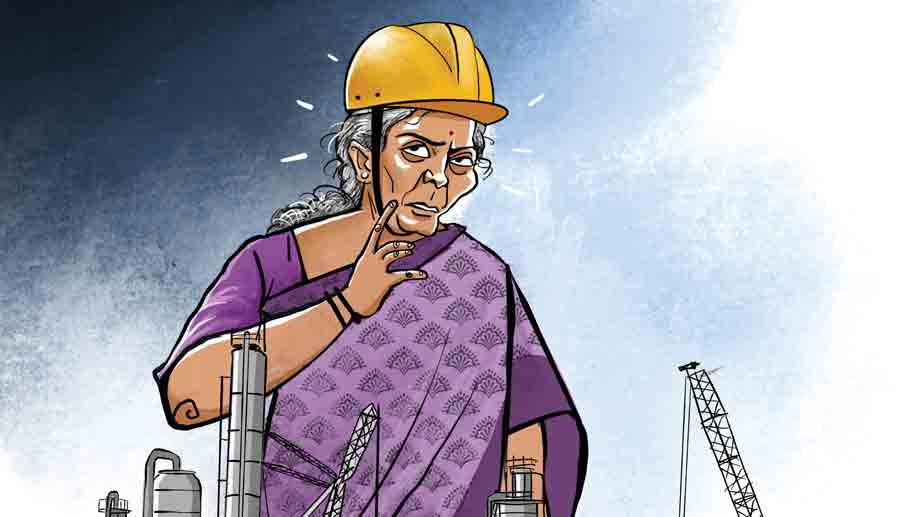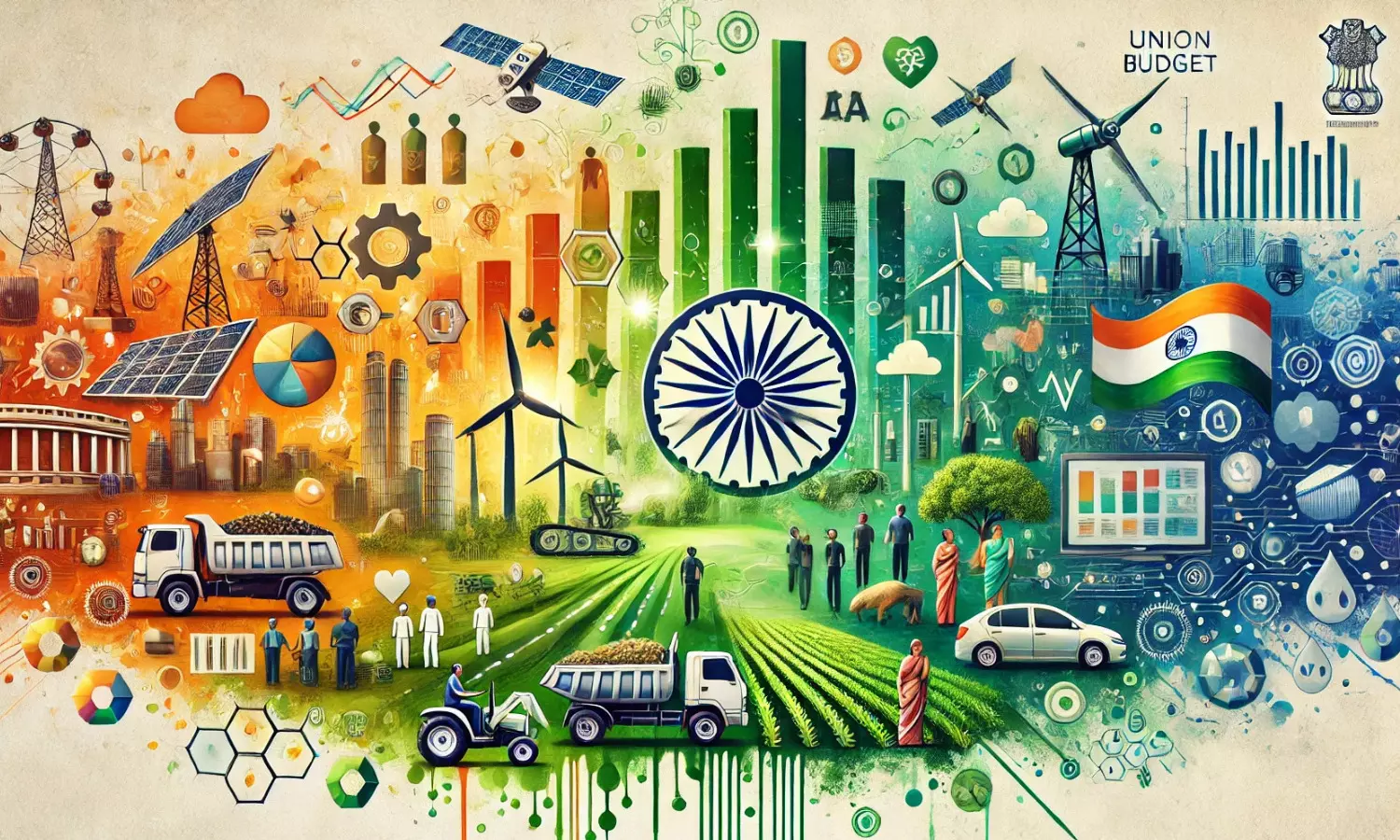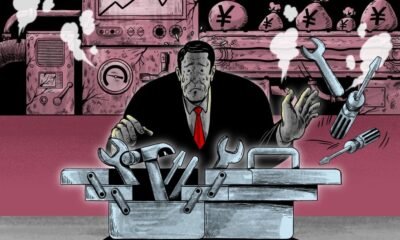Opinion
All About The Union Budget 2025-26—Worthy of Claps, Or Is There Something Lurking That We May Have Missed?
If India had conducted its decadal census on time, the current budget could have been designed with real, data-backed insights into poverty levels, economic distress, migration trends, and employment patterns. Instead, the budget operates on outdated assumptions.
Published
9 months agoon

The Union Budget 2025-26- the finance minister Nirmala Sitharaman opened her speech with a quote from the Telugu poet and playwright Gurajada Apparao – “Desamante Matti Kaadoi, Desamante Manushuloi (A country is not just its soil, a country is its people).” So was this all important sentiment given its due in the budget?
Finance Minister disclosed a fiscal roadmap that attempts to balance economic priorities with electoral considerations. But as the dust settles—is this budget a game-changer, or are we missing something between the numbers?
At the heart of the budget lies the challenge of reviving consumption, particularly among India’s 400 million-strong urban population. With inflation continuing to squeeze household incomes and economic growth projected to slow down to its lowest post-pandemic levels—after an 8% expansion last year—the government had little room for error.
Compounding the uncertainty are external pressures -the looming possibility of fresh US tariffs under a potential Trump presidency, a weakening rupee, and rising global geopolitical risks. While the budget aims to bolster agriculture, infrastructure, and employment, critics argue that many allocations seem strategically timed for electoral gains—most notably, Bihar, which has received a lion’s share of benefits ahead of crucial state elections.

Let us look at the key points
- Agriculture at the Forefront—But Is It Enough?
Agriculture has taken centre stage, with a notable increase in the cap for subsidised Kisan Credit Card loans to ₹7 lakh. Targeted interventions in pulses, cotton, and makhana production signal the government’s intent to secure food supply chains. The Rural Prosperity and Resilience programme, designed to curb migration and boost rural incomes, has been announced with much fanfare—but execution remains the key question. Will this translate into real change, or will it end up as another well-intentioned but under-delivered initiative?
- Infrastructure Push—A Case of Too Little, Too Late?
Infrastructure spending has been raised modestly to ₹11.2 trillion, a number that some analysts see as inadequate given the economic headwinds. The announcement of major projects in Bihar, including new airports and irrigation systems, has drawn both applause and scrutiny. Is this a genuine development push or an election-time sweetener? Meanwhile, the ambitious Nuclear Energy Mission targets 100 GW by 2047, but concerns over its feasibility and financing remain.
- Middle Class & Tax Relief—A Shallow Victory?
The middle class, often the swing vote in elections, has seen some tax relief. However, skeptics argue that these measures are unlikely to provide the kind of boost to consumption that the economy desperately needs. With inflation still biting and employment growth lagging, mere tax cuts may not be enough to revive demand.
- Defence and Markets—Mixed Reactions
Defence spending has climbed to ₹6,81,210 crore, with an emphasis on modernisation and self-reliance in critical sectors. However, some analysts point out gaps in strategic defence allocations, especially concerning long-term geopolitical threats.
Markets reacted cautiously—the consumer-driven sectors saw gains, but infrastructure and capital-intensive stocks dipped. The muted response suggests that while the budget offers some positives, its real impact will depend on execution and the broader economic climate in the coming months.

Examining the key points
1) Agriculture. The Growth Engine or Just Political Fertilizer?
Agriculture has been placed at the forefront of India’s economic expansion, and the government is making a grand show of its commitment to the sector. But is it a genuine push for rural prosperity, or is this budget simply sowing electoral promises ahead of the polls?
The Prime Minister Dhan-Dhaanya Krishi Yojana, a flagship initiative, targets 100 low-productivity agricultural districts, aiming to improve yield, encourage crop diversification, and enhance post-harvest infrastructure. The much-publicized Kisan Credit Card (KCC) loan limit hike from ₹5 lakh to ₹7 lakh is expected to benefit 1.7 crore farmers—but will it be enough to ease their financial struggles?
A six-year mission for self-reliance in pulses production has been introduced, with a focus on tur, urad, and masoor. Cooperatives like Nafed and NCCF will procure pulses for four years under agreements with farmers. Additionally, a five-year cotton mission aims to boost productivity and promote extra-long staple cotton varieties. In Bihar, the politically significant makhana sector will receive dedicated support through the newly established Makhana Board, which will oversee production, processing, and marketing.
Thus, A well-placed boost for Bihar, or just another attempt to win votes?
2) Employment in Rural India. Real Jobs or Just a Stopgap Measure?
To curb rural unemployment, the ‘Rural Prosperity and Resilience’ programme promises employment generation, particularly for women, young farmers, marginal farmers, and landless families. While this sounds promising, the real test will be in execution. The government also plans to formally register India’s growing gig economy workforce, offering access to welfare schemes such as healthcare.
3) Infrastructure and Manufacturing. A Modest Push, but Is It Enough?
With ₹11.2 trillion allocated for capital expenditure, the government claims to be strengthening India’s infrastructure and manufacturing backbone. However, the increase is only marginal compared to last year, raising concerns about whether it is enough to fuel long-term economic growth.
Key projects include –
—New Greenfield airports in Bihar
—Expansion of Patna Airport and Bihta’s brownfield airport
—Western Kosi Canal ERM project, benefiting over 50,000 hectares of agricultural land
—The National Institute of Food Technology, Entrepreneurship, and Management in Bihar, aimed at boosting food processing in Eastern India
—The manufacturing sector, currently contributing just 17% of GDP, is set to receive a push through increased funding for startups and innovation. Meanwhile, the Nuclear Energy Mission is being positioned as a key driver of clean energy, with a target of 100 GW of nuclear power by 2047.
4) Tax Reforms. A Win for the Middle Class or a Cosmetic Fix?
The government has made a big splash with tax relief for the middle class. The income tax exemption threshold has been raised from ₹8,074 to ₹14,800, aimed at boosting consumption, savings, and investment. Additionally, a new tax bill is expected next week to simplify taxation further.
While salaried professionals have welcomed these changes, opposition leaders have criticized them for failing to address India’s core issue—employment generation. After all, tax relief only works if people have jobs and rising incomes to begin with.

5) Defence Spending. A Strategic Priority or Just Bigger Numbers?
With ₹6,81,210 crore allocated for defence, marking a 9.5% increase, the government continues its focus on military modernisation.
Key allocations include:
₹1,92,387 crore for capital outlay
₹48,614 crore for aircraft and aero engines
₹24,390 crore for the naval fleet
₹63,099 crore for other equipment
While these numbers look impressive, some defence experts argue that gaps remain, especially in emerging warfare technologies and cyber defence.
6) Tech & AI. The Government’s New Darling?
With ₹500 crore allocated for an AI Centre of Excellence in Education, the government seems eager to position AI as a pillar of India’s digital future. The Deep Tech Fund aims to support AI startups in healthcare diagnostics, agricultural forecasting, and manufacturing automation, showing a clear focus on leveraging AI for public welfare.
Additionally, state governments will receive funding to implement AI-driven solutions for urban planning and public service delivery. The policy framework encourages research collaborations between academia and industry, backed by dedicated funding for hardware infrastructure and computing resources.
But here’s the real game-changer: New AI governance guidelines. The government is setting a precedent by focusing on data privacy, algorithmic transparency, and ethical AI deployment in public institutions. While this is a step in the right direction, the real challenge lies in enforcement. Can the government balance AI innovation with strong regulatory oversight, or will it become another bureaucratic maze?
Market Reactions
The stock markets reacted with a blend of optimism and skepticism.
Losers: Infrastructure stocks like Larsen & Toubro, PNC Infra, and NBCC took a hit, thanks to the budget’s modest capital expenditure growth. Investors had expected a more aggressive push.
Winners: Consumer-focused sectors benefited from tax relief, with FMCG, auto, and real estate stocks rallying.
Fertiliser and pipe-making companies surged following the extension of the water supply scheme and increased urea supply.
However, the budget has also triggered political debates, particularly over its perceived bias towards Bihar (which heads to elections soon). Congress MP Jairam Ramesh accused the government of ignoring Andhra Pradesh, while DMK MP Dayanidhi Maran called the tax reforms “confusing.”
Analysing The Tax Slabs.
A Real Middle-Class Bonanza or Just Clever Accounting?
One of the biggest headlines of Budget 2025-26 was income tax relief for the middle class. The New Tax Regime aims to ease the tax burden, especially for those earning up to ₹12 lakh annually.
Key Highlights –
Standard deductions push the exemption limit to ₹12.75 lakh for salaried individuals.
Taxpayers save ₹80,000 on an income of ₹12 lakh, ₹70,000 on ₹18 lakh, and ₹1.1 lakh on ₹25 lakh.
New Tax Slabs (Budget 2025-26)
Income Range Tax Rate
Up to ₹4 lakh No tax
₹4 lakh to ₹8 lakh 5%
₹8 lakh to ₹12 lakh 10%
₹12 lakh to ₹16 lakh 15%
₹16 lakh to ₹20 lakh 20%
₹20 lakh to ₹24 lakh 25%
Above ₹24 lakh 30%
At first glance, this appears to be a big win for the middle class. But here’s the catch: Where’s the relief for those earning ₹4-8 lakh, who still pay 5%? The exemption limit has increased, but the lower tax brackets haven’t been completely exempted—which means the lowest earners still bear a disproportionate tax burden.
Moreover, salaried professionals may celebrate today, but with inflation biting into real incomes and employment generation still a major issue, – will these savings translate into greater spending, or will they simply be eaten up by rising living costs?

Now Let Us Analyse What We Don’t See
The Union Budget 2025-26 has come and gone, but many of India’s fundamental challenges remain unaddressed. Perhaps the real story is not in what was spoken in the budget speech but in what was left unsaid.
One figure and three key questions expose the glaring omissions in this budget. The figure in question?
The allocation of less than ₹600 crore for the decadal census, which has already been delayed since 2021. By contrast, the Union Cabinet, back in December 2019, had approved ₹8,754.23 crore for conducting the census and ₹3,941.35 crore for updating the National Population Register (NPR). The math is clear—this budget allocation signals that the census is unlikely to take place in 2025 either.
The census, a once-in-a-decade exercise, is more than a headcount; it is the backbone of policymaking, economic planning, and social welfare distribution. Its continued delay raises some serious concerns.
1) Who really is the middle class?
The absence of fresh census data means we are operating in the dark when defining the middle class. Various institutions have attempted to define this category, but without updated government figures, any tax relief or economic policy aimed at them is built on uncertain ground.
Pew Research Center (2021) estimated that India’s middle class shrank by 32 million due to the pandemic, making up 60% of the global contraction of this economic group.
The National Council of Applied Economic Research defines a middle-class household as one with an annual income between ₹2 lakh and ₹10 lakh.
People Research on India’s Consumer Economy (PRICE, 2022) defines it differently—middle-class households earn between ₹5 lakh and ₹30 lakh per year, while individuals earn between ₹1.09 lakh and ₹6.46 lakh per year.
Especially, with inflation pushing essential goods and services further out of reach, the pressure on household finances has only grown. Yet, consumer goods companies have repeatedly flagged a decline in consumption, particularly among non-premium buyers. Without a proper census, therefore, the tax slab tweaks seem more like a shot in the dark rather than a well-calibrated policy decision.
2. Who is Benefiting from the Tax Reforms?
The Finance Minister announced changes in income tax slabs, marketed as a boon for the middle class. But the lack of fresh demographic data makes it difficult to assess who truly benefits.
Consider this – the government classifies households earning less than ₹8 lakh per year as part of the Economically Weaker Section (EWS), making them eligible for certain reservations. But does this align with the economic reality of the so-called middle class? PRICE’s research indicates that the lowest-income households in India earn one-seventh of the average household income, while the richest households earn up to 50 times more.
3. Can Welfare Schemes Be Effectively Implemented Without Census Data?
Welfare schemes depend on accurate population data to reach those who need them most. A delayed census means that millions who require aid may be falling through the cracks. If India’s poverty levels have drastically shifted post-pandemic, as global research suggests, how can the government ensure that food security programs, housing schemes, and employment programs are reaching the right beneficiaries?
The census is not just a statistical exercise; it is the foundation of resource allocation. Without it, government spending on welfare is akin to navigating without a map.

The Last Bit
If India had conducted its decadal census on time, the current budget could have been designed with real, data-backed insights into poverty levels, economic distress, migration trends, and employment patterns. Instead, the budget operates on outdated assumptions.
Wouldn’t it be more effective for the Finance Minister to acknowledge these knowledge gaps and prioritize funding for a nationwide census? Instead, what we have is an election-year budget that attempts to woo voters without fully understanding their economic realities.
Tax policies, income definitions, and welfare allocations—all of these depend on accurate data. Yet, India continues to delay its most critical survey. Until this missing piece is addressed, every subsequent budget is merely an educated guess rather than a strategic roadmap for national growth.
While the union budget makes all the right noises—agriculture incentives, infrastructure expansion, tax relief, AI, startups and defence modernisation—it ultimately hinges on execution. Will these allocations translate into real growth, or will they merely serve as pre-election optics?
As always, the devil is in the details, and the coming months will reveal whether this budget is truly a growth engine or just another election-season fertilizer.
You may like
-


A Trade War That Just Won’t Quit. As Trump’s Tariffs Hit, China Stays The Course, For Xi’s Its Business As Usual Strategy
-


China To Cut Inflation Outlook To 20-Year Low, Eyes Fresh Stimulus At ‘Two Sessions’ To Boost Economy
-


DeepSeek Ai Rush. China’s AI Contender Gears Up for Next Big Launch Even As It Gets Xi Jinping’s Blessings
-


Trump’s Latest Tariff Move on Mexico and Canada. Import Taxes Back on Track Hinting At A Full Blown Trade War!
-


Global Economic Pulse, UK’s Surprise Growth, US Inflation Jumps While China And Japan Battle It Out—Who’s Leading And Who’s Lagging?
-


All You Need To Know About The New Income Tax Bill 2025, Debuts With A New Concept Of ‘Tax Year’. A Meaningful Change Or Just A Facelift?
